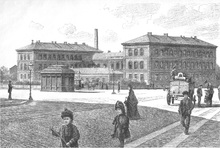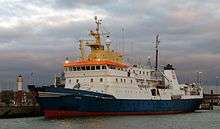Technical University of Denmark
| Danmarks Tekniske Universitet | |
.svg.png) | |
Former names |
Den Polytekniske Læreanstalt (1829–1933) Danmarks Tekniske Højskole (1933–1994) |
|---|---|
| Type | Public, Technical |
| Established | 1829 |
| Chairman | Sten Scheibye |
| President | Anders Bjarklev |
| Provost | Henrik C. Wegener |
| Dean | Martin P. Bendsøe & Martin Vigild |
| Director | Claus Nielsen |
Academic staff | 2,003[1] |
Administrative staff | 1,540[1] |
| Students | 11,190[1] |
| Undergraduates | 6,803[1] |
| 1,200[1] | |
| Location | Kgs. Lyngby, Lyngby-Taarbæk Municipality, Copenhagen, Denmark |
| Colors | Red and gray |
| Nickname | DTU |
| Affiliations | EUA, CDIO, TIME, CESAER and Eurotech |
| Sports | Rugby union, Volleyball |
| Website | www.dtu.dk/ |
The Technical University of Denmark (Danish: Danmarks Tekniske Universitet), often simply referred to as DTU, is a university in Kongens Lyngby, just north of Copenhagen, Denmark. It was founded in 1829 at the initiative of Hans Christian Ørsted as Denmark's first polytechnic, and is today ranked among Europe's leading engineering institutions.
DTU, along with École Polytechnique Fédérale de Lausanne, Eindhoven University of Technology and Technical University of Munich, is a member of EuroTech Universities Alliance.[2]
History
DTU was founded in 1829 as the 'College of Advanced Technology' (Danish: Den Polytekniske Læreanstalt) with the physicist Hans Christian Ørsted, then a professor at the University of Copenhagen, as one of the driving forces. The inspiration was the École Polytechnique in Paris, France which Ørsted had visited as a young scientist. The new institution was inaugurated on 5 November 1829 with Ørsted as its principal, a position he held until his death in 1851.[3]

The new college's first home was two buildings in Studiestræde and St- Pederstræde in central Copenhagen. Although expanded several times, they remained inadequate and in 1890 a new building complex was inaugurated in Sølvgade in 1890. The new buildings were designed by the architect Johan Daniel Herholdt.[3]
In 1903 the College of Advanced Technology commenced the education of electrical engineers in addition to the construction engineers, production engineers and mechanical engineers already educated at the college.
In the 1920s space had once again become insufficient and in 1929 the foundation stone was laid for a new school at Østervold. Completion of the building was delayed by World War II and it was not completed until 1954.[3]
From 1933 the institution was officially known as Danmarks tekniske Højskole (DtH), which was usually translated as the 'Technical University of Denmark'. On 1 April 1994, in connection with the joining of Danmarks Ingeniørakademi (DIA) and DTH, the Danish name was changed to Danmarks Tekniske Universitet, in order to include the word 'University', thus giving rise to the initials DTU by which the university is commonly known today. The formal name, Den Polytekniske Læreanstalt, Danmarks Tekniske Universitet, still includes the original name.


In 1960 a decision was made to move the College of Advanced Technology to new and larger facilities in Lyngby north of Copenhagen. They were inaugurated on 17 May 1974.[3]
On 23 and 24 November 1967 the University Computing Center hosted the NATO Science Committee's Study Group first meeting discussing the newly coined term 'Software Engineering'.[4]
On 1 January 2007 the university was merged with the following Danish research centers: Forskningscenter Risø, Danmarks Fødevareforskning, Danmarks Fiskeriundersøgelser (from 1 January 2008: National Institute for Aquatic Resources; DTU Aqua), Danmarks Rumcenter, and Danmarks Transport-Forskning.
Organization and administration
The university is governed by a board consisting of 10 members: 6 members recruited outside the university form the majority of the board, 1 member is appointed by the scientific staff, 1 member is appointed by the administrative staff, and 2 members are appointed by the university students.
The President of DTU is appointed by the university board. The president in turn appoints deans, and deans appoint heads of departments.
Since DTU has no faculty senate, and since the faculty is not involved in the appointment of president, deans, or department heads, the university has no faculty governance.[5]
Departments
- DTU Aqua, National Institute for Aquatic Resources
- DTU Business, DTU Executive School of Business
- DTU Cen, Center for Electron Nanoscopy
- DTU Chemical Engineering, Department of Chemical and Biochemical Engineering
- DTU Chemistry, Department of Chemistry
- DTU Civil Engineering, Department of Civil Engineering
- DTU Compute, Institut for Matematik og Computer Science
- DTU Danchip, National Center for Micro and Nanofabrication
- DTU Diplom, Department of Bachelor Engineering
- DTU Electrical Engineering, Department of Electrical Engineering
- DTU Environment, Department of Environmental Engineering
- DTU Executive School of Business
- DTU Food, National Food Institute
- DTU Fotonik, Department of Photonics Engineering
- DTU Management Engineering, Department of Management Engineering
- DTU Mechanical Engineering, Department of Mechanical Engineering
- DTU Nanotech, Department of Micro-and Nanotechnology
- DTU Physics, Department of Physics
- Risø DTU, National Laboratory for Sustainable Energy
- DTU Space, National Space Institute
- DTU Systems Biologi, Department of Systems Biology
- DTU Library, Technical Information Center of Denmark
- DTU Vet, National Veterinary Institute
- DTU Wind Energi, Department of Wind Energy
- DTU Transport, Department of Transport: The department provides Transportation and Logistics master's degree programs in engineering and technology. A Ph.d. Programme is also offered.[6]
- DTU Mathematics
Research centers
- Arctic Technology Centre
- Center for Facilities Management
- Center for Biological Sequence Analysis – chair Søren Brunak
- Center for Information and Communication Technologies
- Center for Microbial Biotechnology
- Center for Phase Equilibria and Separation Processes
- Center for Technology, Economics and Management
- Center for Traffic and Transport
- Centre for Applied Hearing Research
- Centre for Electric Power and Energy
- Combustion and Harmful Emission Control
- The Danish Polymer Centre
- IMM Statistical Consulting Center
- International Centre for Indoor Environment and Energy
- Centre for Advanced Food Studies
- Nano-DTU
- Fluid-DTU
- Food-DTU
- EnergiDTU
Campus
The university is located on a plain known as Lundtoftesletten in the northeastern end of the city of Lyngby. The area was previously home to the airfield Lundtofte Flyveplads.
The campus is roughly divided in half by the road Anker Engelunds Vej going in the east-west direction, and, perpendicular to that, by two lengthy, collinear roads located on either side of a parking lot. The campus is thus divided into four parts, referred to as quadrants, numbered 1 through 4 in correspondence with the conventional numbering of quadrants in the Cartesian coordinate system with north upwards.
Controversy
DTU was the subject of controversy in 2009 because the former institute director of the Department of Chemistry[7] was a high-ranking member of Scientology.[8] In relation to this, the university was accused of violating the principles of free speech by threatening to fire employees who voice their criticism of the institute director.[9][10][11][12][13] On 7 April 2010, his successor was announced, at a department meeting, as Erling Stenby,[14] who officially took over as Director on 1 May 2010.
Shortly thereafter, the university management threatened Rolf W. Berg with dismissal for publicly criticizing the university.[15]
Rankings
In November 2007 the Times Higher Education Supplement put the university as number 130 in their ranking of the universities of the world and number 122 in 2010.[16]
- In "The World's Most Innovative Universities" 2015 ranking by Thomson Reuters, DTU is ranked:[17]
- No. 1 in the Nordic countries
- No. 43 in the World
- In the "engineering" category in the QS subject rankings, DTU is ranked:
- No. 2 in the Nordic countries
- No. 36 in the World
- On the Leiden Ranking's 2008 "crown indicator" list of Europe's 100 largest universities in terms of the number of Web of Science publications in the period 2000–2007, DTU is ranked:[18]
- No. 1 in the Nordic countries
- No. 5 in Europe
- In the 2015 QS World University Rankings[19] DTU is ranked:
- No. 112 in the World
- In the 2013 Leiden Ranking[20] DTU is ranked:
- No. 45 in the World
- No. 7 in Europe
- In the 2013-2014 Times Higher Education World University Rankings[21] DTU is ranked:
- No. 121 in the World (No. 31 in the "Engineering & Technology" category)
Student organizations
- A student union at DTU is the 168-year-old Polyteknisk Forening.
- A student union at DTU is the maritime student association Nul-kryds formed in 1947.
Notable alumni and faculty
- Henrik Pontoppidan, Nobel Prize in Literature laureate
- Henrik Dam, Nobel Prize in Physiology or Medicine laureate
- Harald Bohr, mathematician
- Johan Jensen, mathematician
- Carsten Thomassen, mathematician
- Ludwig A. Colding, physicist and civil engineer
- Martin Knudsen, physicist
- Morten Bo Madsen, physicist
- Rodney Cotterill, physicist
- Jakob Stoustrup, control theory scientist
- Andreas Mogensen, astronaut
- Ove Arup, founder of Arup Group
- Per Vilhelm Brüel, co-founder of Brüel & Kjær
- Craig R. Barrett, former CEO of Intel
- Jørgen Lindegaard, former CEO of the SAS Group
- Henrik O. Madsen, former CEO of DNV GL
- Dines Bjørner, computer scientist
- Anders Hejlsberg, software engineer
- Henrik Wann Jensen, computer graphics researcher
- Per Brinch Hansen, computer scientist
- Jakob Nielsen, web usability consultant
- Anker Engelund, civil engineer
- Povl Ole Fanger, HVAC engineer
- Peder Oluf Pedersen, electroacoustic engineer
- Poul Henningsen, author, architect and critic
- Ebbe Sand,[22] former professional footballer
- Haldor Topsøe, Founder and former chairman of Haldor Topsøe
See also
- Risø DTU National Laboratory for Sustainable Energy
- Top Industrial Managers for Europe (TIME), network for student mobility
- Technologist, magazine published by Eurotech Universities
Notes and references
- 1 2 3 4 5 "DTU Årsrapport 2013". DTU. Retrieved 3 September 2014.
- ↑ "EuroTech Universities Alliance". EuroTech Universities. Retrieved 21 September 2015.
- 1 2 3 4 "Den Polytekniske Læreanstalt". Gyldendal. Retrieved 14 February 2010.
- ↑ NATO Unclassified Document AC/137-D/326
- ↑ "Board of Governors". Retrieved 8 November 2009.
- ↑ Transportation Logistics Programs at DTU
- ↑ "Ole W. Sørensen". Kemi.dtu.dk. 4 September 2006. Retrieved 17 October 2011.
- ↑ Lise Richter (13 October 2011). "DTU-leder bruger Scientology-metoder". information.dk. Retrieved 17 October 2011.
- ↑ Kristian Villesen (13 October 2011). "'Jeg kan ikke forestille mig, at vi knægter ytringsfriheden'". information.dk. Retrieved 17 October 2011.
- ↑ Lise Richter (13 October 2011). "Forsker står til fyring for kritiske udtalelser". information.dk. Retrieved 17 October 2011.
- ↑ "Lig på bordet". information.dk. Retrieved 17 October 2011.
- ↑ Lise Richter. "Trivselsundersøgelse holdes hemmelig". information.dk. Retrieved 17 October 2011.
- ↑ Lise Richter. "DTU-leder kører de ansatte i sænk". information.dk. Retrieved 17 October 2011.
- ↑ "Erling Halfdan Stenby". Kt.dtu.dk. 18 July 2006. Retrieved 17 October 2011.
- ↑ "Forsker står til fyring for kritiske udtalelser". 10 May 2009. Retrieved 8 November 2009.
- ↑ Sara Rosendal. "DTU tager tigerspring på listen over verdens bedste universiteter" (in Danish). ing.dk. Retrieved 15 November 2007.
- ↑ https://www.reuters.com/article/2015/09/15/idUSL1N11K16Q20150915
- ↑ http://www.cwts.nl/ranking/top100_green_lst.html
- ↑ "QS World University Rankings". Topuniversities. Retrieved 20 September 2015.
- ↑ "World University Rankings". Leiden. Retrieved 1 September 2013.
- ↑ "World University Rankings 2013-2014". Times Higher Education. Retrieved 26 July 2014.
- ↑ "Sådan blev Ebbe Sand Professionel fodboldspiller".
External links
| Wikimedia Commons has media related to Technical University of Denmark. |
- Official website
- History of DTU
- International Education at DTU
- Map of the Lyngby DTU Campus
- DTU Alumni Association
Coordinates: 55°47′8.87″N 12°31′17.52″E / 55.7857972°N 12.5215333°E